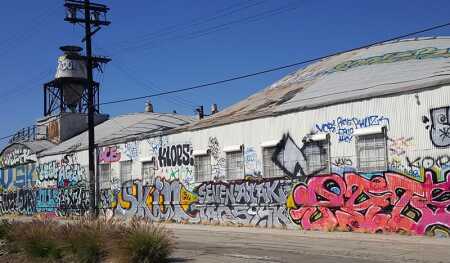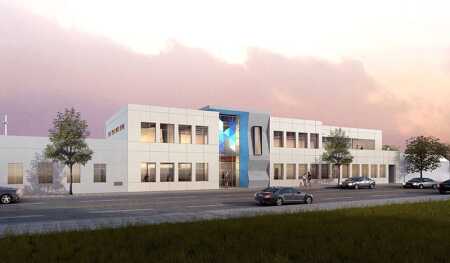East Los Angeles is shaping up to be one of the unlikely centers of southern California’s emerging bioscience industry. Bioscience has long had a presence in Los Angeles, given its collection of leading medical centers and universities. However, for years it has been overlooked as a destination for life science innovation and investment as San Francisco, Boston, and San Diego emerged as bioscience cluster powerhouses. Now, thanks to a shared vision among city and county leaders, local universities, and the bioscience industry, a concerted, cross-sector effort is activating a network of bioscience clusters across the region. East Los Angeles is one of those nodes.
The eastside cluster, known as the LA Bioscience Corridor, is anchored by the LAC+USC Medical Center and the USC Health Sciences Campus on the west, and California State University, Los Angeles (Cal State L.A.) and Grifols (a multinational pharmaceutical company) on the east. At the center of these university and research centers is a promising stretch of underused industrial land that is ready for redevelopment.
A key piece to cultivating bioscience innovation and industry depends on real estate—having lab space to operate and grow a life science startup. The LA Bioscience Corridor is home to some of Los Angeles’s last remaining industrial land. Unlike other parts of the region where industrial land is being rezoned for residential conversion, this East Los Angeles area is primed for hosting the next wave of manufacturing and production.
When real estate investment partners Agora Partners and ASG Real Estate came upon an 80-year-old, 22,000-square-foot (2,000 sq m) furniture factory and warehouse in the corridor, they saw the potential and opportunity to create that new generation of industrial space for East Los Angeles, and advance the vision for creating a thriving bioscience hub.
“We were looking for a particular building type in a more affordable neighborhood, when we came upon this building, which has great bones and is really beautiful. It quickly became important to understand how bioscience uses could fit within this type of building,” says Howard Kozloff, managing partner of Agora Partners.
The abandoned furniture warehouse was purchased and readied for adaptive use. The building, aptly named HATCH, will provide flexible working space to emerging bioscience companies that have outgrown their incubators and require purpose-built, dedicated lab and office space.
HATCH is regarded as a much-needed and valuable contribution to Los Angeles’s bioscience ecosystem. Part of the vision for this area is to create a place where companies can translate cutting-edge academic research into commercialized medical treatments and technologies that make it into hospitals and doctors’ offices.

When real estate investment partners Agora Partners and ASG Real Estate came upon an 80-year-old, 22,000-square-foot (2,000 sq m) furniture factory and warehouse in the corridor, they saw the potential and opportunity to create that new generation of industrial space for East Los Angeles, and advance the vision for creating a thriving bioscience hub.
Located within an industrial zone, HATCH will offer more than 17,000 square feet (1,600 sq m) of available lab space that can be configured for up to eight bioscience tenants. “HATCH is transforming a building that, in its prior iteration, had no more than four employees at one time into a dynamic hub of bioscience activity, accommodating over 50 people from all bioscience disciplines,” says Kozloff.
While Los Angeles has numerous research centers and a growing number of incubators, HATCH is its first privately funded, multitenant lab space. Being the local pioneers for this type of real estate product has come with some challenges. In particular, financing has been complicated.
Allan Glass, president and CEO of ASG Real Estate, says, “Being a first-mover requires us as developers to extract the emerging storyline between the industry and the real estate. Our research needs to be deeper than direct comparable sales and current market rents, which simply don’t exist. We need to understand who the stakeholders are, develop working relationships with them, take consensus of where priorities lie, and establish what is the most immediate missing need.”
The HATCH team has extrapolated a variety of data points to convey Los Angeles’s bioscience potential to capital investors. They’ve learned that there is also a catch-22 between buildout and tenant commitments. Bioscience startups typically do not commit to a space unless it is built out; however, funding a full buildout is challenging without tenant commitments. In addition, the extent of buildout for lab space can vary greatly, with costs ranging from $50 to $1,000 per square foot ($538 to $10,760 per sq m). To reduce risk and costs, HATCH has decided to allow specialty buildout to accommodate the range of company needs between creative office space environs and fully equipped wet labs and clean rooms.
Having overcome the hurdles of being a first-mover and seeing the opportunity of the LA Bioscience Corridor, the HATCH team continues to seek out additional opportunities for bioscience-focused development projects.
A stone’s throw from HATCH, Cal State L.A. has broken ground on LA BioSpace, an on-campus incubator that is scheduled to open next year. LA BioSpace is funded through a combination of county, federal, and philanthropic grants, and represents a cross-sector commitment that HATCH has successfully leveraged with private sector investors. LA BioSpace aims to be a launchpad for early-stage companies to take shape in the LA Bioscience Corridor.
“Our goal is to capture companies graduating from the academic and incubator environment and house them in HATCH, so that they can stay in Los Angeles and continue to grow locally,” says Glass.
In addition to its multitenant labs and offices for ascending bioscience companies, HATCH hopes to be a venue for bridging researchers, inventors, entrepreneurs, and venture capital firms. HATCH’s coworking environment and shared amenities will also serve as educational programming space to connect in-house companies, PhDs, and postdoctorates to young, local science, technology, engineering, and mathematics (STEM) students.
LA Bioscience Hub (LABH), a place-based nonprofit entity, is one of the local partners with which HATCH will organize its community programming. LABH focuses on shaping the LA Bioscience Corridor to become a thriving innovation center that creates good jobs for the local workforce. LABH brings an equitable economic development approach to the corridor’s growth through partnerships that can weave the benefits of redevelopment, like HATCH, into the fabric of the community. LABH’s core program, Biotech Leaders Academy, strengthens career pathways for diverse, East Los Angeles community college students through entrepreneurship training and internships in the bioscience industry. The nonprofit organization hopes to make HATCH’s future company tenants program partners.
“The addition of HATCH to the LA Bioscience Corridor is a catalytic development project for rooting more bioscience research and manufacturing enterprises in Los Angeles. The public and private investments coming into this area can lead to new, much-needed economic opportunity in East Los Angeles,” says Cecilia V. Estolano, executive director of LA Bioscience Hub.
Los Angeles is a wellspring of ingenuity with the right ingredients to flourish into a competitive bioscience force that continues to attract investors nationally and internationally. With ample space for new bioscience developments that can help local companies prosper, the LA Bioscience Corridor is on the cusp of becoming a center for leading-edge intellectual and commercial bioscience activity.
HATCH is a critical piece in writing Los Angeles’s bioscience story. Having state-of-the-art spaces for growing startup companies is crucial to the prosperity of the bioscience industry both in the LA Bioscience Corridor and in Los Angeles as a region. Los Angeles is home to talent, innovation, wealth, and land. The final ingredient is lab space, and the opportunity to create it awaits.





